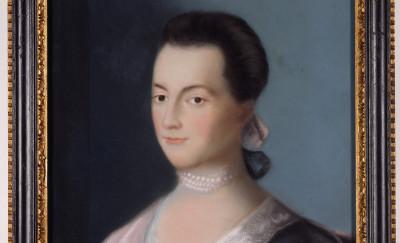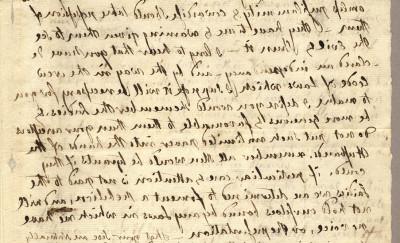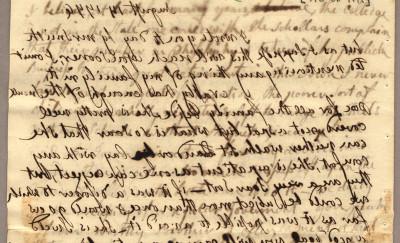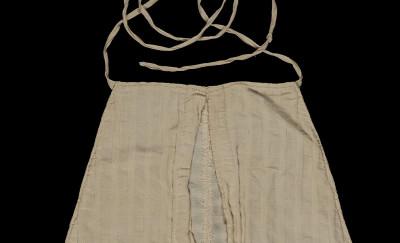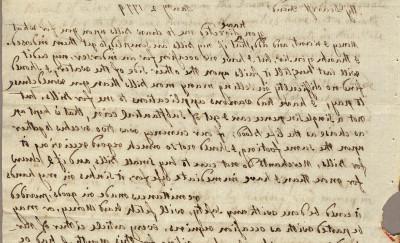Revolutionary Abigail Adams
Inquiry Question: Who was Abigail Adams, and what roles did she take on during the Revolutionary Era?
Through her letters and belongings we will explore the ways in which Abigail shaped—and was shaped by—the political and social events unfolding around her.
Source Set
Download Source Set
Glossary
Smallpox: a deadly, contagious disease that sickened or killed many people in colonial America. In the early 1800s, scientists developed the first vaccine to protect people from smallpox.
Portia: the nickname Abigail Adams used for herself when writing to family and friends
Continental Congress: the governing body for the United States during the American Revolution. It was composed of delegates from the 13 colonies
Parliament: The governing body in Great Britain responsible for making the laws. American colonists who supported the Revolution believed it was unfair that Parliament could tax them even though they had no colonial representation in Parliament
Analyzing Letters
As you read the letters in this set, consider:
To whom did Abigail write this letter?
When did she write it?
What was happening at the time the letter was written? In other words, what is the context for the letter?
What roles does Abigail describe taking on in this letter?
Analyzing Objects
For the objects, ask yourself:
What is this?
What was its purpose?
What can this item tell us about Abigail Adams?
Created by MHS Staff and Emily Spence
This portrait of Abigail Adams (1744-1818) was painted by Benjamin Blyth circa 1766.
Abigail Adams was born 11 November 1744, in Weymouth, Massachusetts. She had no formal schooling, but her education included reading works by British poets and authors like William Shakespeare, John Milton, and Alexander Pope. She married John Adams in 1764. Her husband's frequent absences from home often left Abigail with the children to raise, a farm to manage, the household and tenants to supervise, and extended family and friends to care for—all while the Revolution in Boston unfolded on her doorstep. The letters she exchanged with John and others reveal her cares and worries, as well as her opinions and advice, offering an extraordinary view of everyday life in 18th-century New England.
Citation: Abigail Adams (Mrs. John Adams), Portrait, pastel on paper by Benjamin Blyth, circa 1766, Massachusetts Historical Society, http://mdj.imtiazqazi.com/database/69
Let these truths says the admired Farmer be indelibly impressed on our Minds that we cannot be happy without being free that we cannot be free without being secure in our property—that we cannot be secure in our property if without our consent others may as by right take it away—we know too well the blessings of freedom, to tamely resign them it
In this 3 February 1775 letter from Abigail to her friend, playwright and poet Mercy Otis Warren, she expresses her upset over the King’s rejection of the Suffolk Resolves, an attempt by the colonies to establish fair trading rules between the colonies and Great Britain. Taking on the role of a political commentator, Abigail explains why she disagrees so strongly with the actions of the King and Parliament.
Citation: Letter (draft) from Abigail Adams to Mercy Otis Warren, [3] February 1775, Draft copy from the Adams Family Papers, Massachusetts Historical Society, http://mdj.imtiazqazi.com/database/952
Charlstown is laid in ashes. The Battle began upon our intrenchments upon Bunkers Hill, a Saturday morning about 3 o clock and has not ceased yet and tis now 3 o'clock Sabbeth afternoon…How many have fallen we know not—the constant roar of the cannon is so distressing that we can not Eat, Drink or Sleep. May we be supported and sustaind in the dreadful conflict.
The day following the Battle of Bunker Hill, on 18 June 1775, Abigail writes to John informing him of the death of their friend, Dr. Joseph Warren, who was killed in battle. While John is away in Philadelphia, Abigail is his eyes and ears in Boston reporting on the latest news. Abigail acknowledges that John will receive reports from others, but her reports inform him of recent events and, importantly, the mood of the people.
Citation: Letter from Abigail Adams to John Adams, 18 - 20 June 1775 [electronic edition]. Adams Family Papers: An Electronic Archive. Massachusetts Historical Society. http://mdj.imtiazqazi.com/digitaladams/
…and by the way in the new Code of Laws which I suppose it will be necessary for you to make I desire you would Remember the Ladies, and be more generous and favourable to them than your ancestors. Do not put such unlimited power into the hands of the Husbands. Remember all Men would be tyrants if they could. If perticuliar care and attention is not paid to the Laidies we are determined to foment a Rebelion, and will not hold ourselves bound by any Laws in which we have no voice, or Representation.
During the spring and summer of 1776, Abigail exchanged a series of letters with her husband John, who was away at the Continental Congress in Philadelphia. In this famous letter, Abigail writes to her husband to ask that he and the other delegates “remember the ladies” and their independence while they consider independence for the colonies.
However, there is more to this letter than that one line. Abigail also updates John on her life at home with their children in Massachusetts, shares her opinions on current events and politics, and reports on her research into making gunpowder for the troops.
Read John’s response to her letter (page 3, final paragraph). Abigail also writes to Mercy Otis Warren about her ‘new code of laws,’ and John’s response, in this letter (4th paragraph).
Citation: Letter from Abigail Adams to John Adams, 31 March - 5 April 1776 [electronic edition]. Adams Family Papers: An Electronic Archive. Massachusetts Historical Society, http://mdj.imtiazqazi.com/digitaladams/
If we mean to have Heroes, Statesmen and Philosophers, we should have learned women…If much depends as is allowed upon the early Education of youth and the first principals which are instilld take the deepest root, great benifit must arise from litirary accomplishments in women.
In this letter from Abigail to John, Abigail updates John on their daughter Nabby (Abigail) who is sick with smallpox. Abigail also uses the letter, and her role as a mother, to advocate for more education for girls. Abigail argues that women should be well-educated so that they can better raise their children, the country’s future leaders.
Citation: Letter from Abigail Adams to John Adams, 14 August 1776 [electronic edition]. Adams Family Papers: An Electronic Archive. Massachusetts Historical Society. http://mdj.imtiazqazi.com/digitaladams/
…Wherever I go I am Scarcly welcome without I bring my pocket full of [your] Letters…
- Mary Smith Cranch to Abigail Adams, 10 May 1798
Abigail Adams tied this dimity pocket around her waist and wore it under the skirts of her dresses to carry her keys, letters, money and more. During the 18th and early 19th centuries, before pockets were sewn into clothing articles themselves, women commonly wore external pockets like this one.
The quotation in the gray box comes from a letter Abigail’s sister, Mary Smith Cranch, wrote to her in 1798. In the letter, Cranch explains that whenever she visits friends she carries letters from Abigail in her pocket so that she can share with them the latest political news.
Citation: Dimity pocket belonging to Abigail Adams, Dimity with cotton tapes by unknown maker; [Mass.?], late 18th-early 19th century, Massachusetts Historical Society, http://mdj.imtiazqazi.com/database/1835.
I hope you will not think me extravagant, I could account for the expenditure of every shilling to your satisfaction; I will give you one instance of prices here. Yesterday I gave 12 pounds Lawfull Money for one pound of Bohea tea and 14 pounds of ordinary brown sugar. Our crops were so cut of by the drought, and distroyed by the Storm, that 23 Bushels of corn is the sum total of my last years crop. Not a single Barrel of cider was made upon the Farm. I do not exaggerate when I say that 100 and hundreds of families have not a mouth full of Bread to eat. Grain is not to be had at any rate in this State and the Embargoes of other States, has hitherto prevented any supplies.
While John was in France acting as a representative of Massachusetts and, later the United States, during the Revolutionary War, Abigail managed the family farm and made financial decisions. Abigail, like other colonists, used bills (of exchange) as a stand-in for hard currency because there were not enough coins.
In this letter from 2 January 1779, Abigail describes the difficulties caused by high prices and a small yield on their farm, and explains the steps she is taking to make ends meet for her family.
Citation: Letter from Abigail Adams to John Adams, 2 January 1779 [electronic edition]. Adams Family Papers: An Electronic Archive. Massachusetts Historical Society. http://mdj.imtiazqazi.com/digitaladams/
For Teachers
Brief Biography of Abigail Adams
Complete List of Excerpts and Worksheets
Created by MHS staff and Emily Spence
Revolutionary Abigail Adams
Background Reading
- Biography of Abigail Adams
-
Abigail Smith Adams was born 11 November 1744, in Weymouth, Massachusetts, to the Reverend William and Elizabeth (Quincy) Smith. She had no formal schooling, but her education included reading works by Shakespeare, Milton, and Pope. On 25 October 1764, she married John Adams. John Adams’ protracted absences from home (first while traveling the court circuits and later while at the Continental Congress and on diplomatic assignments abroad) often left Abigail with the children to raise, a farm to manage, the household and tenants to supervise, and extended family and friends to care for—all while the Revolution in Boston unfolded on her doorstep. The letters she exchanged with John and other family members reveal her cares and worries, her frank opinions and advice, and give an extraordinary view of everyday life in 18th-century New England.
In 1784, Adams and her daughter Abigail joined John and son John Quincy in Europe. Abigail kept a record of her month-long voyage from Boston to England, her time in England, and her return voyage to America in 1788. During the 12 years of John Adams’ vice-presidency and presidency, Abigail moved between their home in Quincy and the national capitol in New York, Philadelphia, and Washington, D.C., successively. Again, the burden of their household and personal affairs fell on her capable shoulders. Adams also acted as a highly trusted advisor to John throughout his career, including his presidency. In addition, she was also responsible for raising nieces and grandchildren entrusted to her care. Among her notable correspondents were Thomas Jefferson, James Lovell, Benjamin Rush, and Mercy Otis Warren. Abigail Adams died 28 October 1818, at home in Quincy.
Learn about the children of Abigail Adams too! (She writes about her daughter Abigail, or "Nabby," in one of the letters in this set.)
To read the correspondence of John and Abigial Adams, visit the Adams Electronic Archive. The published Adams Family Correspondence is available online at the Adams Papers Digital Editions. A timeline of Abigail's life is available at the Adams Family Timeline.
Close Reading Questions
-
Document-specific questions and glossaries
-
Source: Portrait of Abigail Adams, 1766
-
What observations can you make about Abigail’s appearance How does this picture of Abigail compare to the description of Abigail in the image caption?
-
What about the portrait is similar to pictures we have of ourselves today? What looks different?
-
Why do you think Abigail had this portrait painted?
Source: Letter from Abigail to John 31 March 1776 (Remember the Ladies)
-
What are some concerns Abigail shares in this letter?
-
What are some of the roles you see Abigail playing in this letter?
-
What does Abigail mean when she tells John to “remember the ladies”?
Glossary
-
Pusilanimity (pusillanimity): Lack of courage; timidity
-
Saltpeter: white powder used for preserving food and making gunpowder
-
Tyrant: a person who has complete power and uses it in a cruel or unfair way
-
Independence: freedom from control of another person, group of people or country
Source: Letter from Abigail to Mercy Otis Warren, 3 February 1775
-
What words does Abigail use to describe King George and Parliament? What might this reveal to you about her opinions of them?
-
What does Abigail think the colonies should do in response to the King’s rejection?
-
Abigail wrote this letter to her friend Mercy Otis Warren. What can you infer about Mercy Otis Warren’s education and politics?
Glossary
-
Infatuated: having such strong feelings that one cannot think clearly
-
Infamy: the state of being known for something evil or bad
-
Lord North: Prime Minister of Great Britain 1775
-
Neroism: being controlling or acting like a tyrant, like the Roman emperor Nero
-
Caluminy (Calumny): a false statement about someone meant to hurt their reputation
Source: Abigail Adams’ Dimity Pocket
-
Describe the appearance of the pocket. Does it look like an item that would be used for a purpose or decoration
-
Considering the various responsibilities Abigail had, what kinds of items might Abigail have been buying?
-
In addition to money, what other items might Abigail have carried in her pocket?
Grades 6-8
-
Abigail carried money in her pocket. What does that tell us about the financial freedom and responsibility she enjoyed?
Source: Letter from Abigail to John, 14 August 1776
-
Abigail remarks that education in America was never in “a worse state.” What evidence does she give for this?
-
What reasons does Abigail give for why there should be more educational opportunities for women?
Source: Letter from Abigail to John, 18 June 1775
-
Why do you think Abigail describes the day as decisive
-
According to Abigail, what happened at the battle? What details is she unsure of/does she not know?
-
(Grades 3-5) How does Abigail feel about Dr. Warren’s death? What words does she use that show this?
-
(Grades 6-8) What is the tone of this letter? Provide an example from the text to support your answer.
Glossary
-
Decisive: very important for the final result of a particular situation
-
Ignominiously: shamefully or disgracefully
-
Sabbath: in some religions, the holy day of the week that is used for worship and rest. For Christians like Abigail, Sunday is the Sabbath.
-
Intrenchments (Entrenchment): A system of long narrow holes used by soldiers for defense during a battle.
Source: Letter from Abigail to John, January 2, 1779
-
According to this letter, what are the different ways colonists could pay for goods?
-
What is one frustration Abigail expresses about the current financial situation?
-
Why do you think Abigail wrote this letter to John detailing her recent financial decisions and the overall financial situation in her community?
Glossary
-
Bills (of exchange): a written order to pay a sum of money to a particular person on a particular date. It was a common form of payment in the colonies when there were not enough coins
-
Remittance: money sent to someone to pay for something
-
Hard money: actual, physical coins and cash
-
Expenditure: an amount of money spent
-
Embargo: an official order that bans trade with another country
-
Suggested Activities
-
Activity 1. Drawing Connections: Portrait of Abigail Adams (Grades 3-5)
-
Introduce students to Abigail Adams by first displaying her portrait. Without telling students who she is or background information, ask them to make observations about what they notice in the painting. As they study the painting, they should consider the following:
-
Do you think this person is alive today or a long time ago?
-
How would you describe their clothing? What might this suggest about their wealth and status?
-
Why might this person have wanted to have this painting made?
After students have had time to examine the painting and offer observations, share with students that this is a painting of Abigail Adams. Together, read this short biography of Abigail and ask students if any details about her surprise them based upon the conclusions they drew from her painting.
As the biography stated, this painting was done shortly after John and Abigail’s marriage and may have been made to mark the occasion. Explain to students that in Colonial America, portraits were a way for people to mark a special occasion in their lives or show people something about themselves, similar to the way we use social media today. It was not uncommon for people to be painted in clothing or with items that revealed something about their hobbies, careers or where they lived. You can show students examples of other portraits, such as these:
Now ask students to think about an important event in their lives and draw a portrait of themselves to remember that occasion. In their portrait, they should include items, clothing or a background that tells the viewer more about who they are.
-
-
Activity 2. Integrating Information: Abigail’s various roles
-
“Abigail’s Many Hats” worksheet
Abigail took on many roles for her family and her community. She commented on politics of the times, reported news to John while he was away, took care of her family and family businesses and pushed for more equal treatment of women. In this activity, students read quotes from three of Abigail’s letters to decide which role(s) she most embodies in each.
-
Activity 3. Analyzing Language: Revolutionary Rhetoric
-
Materials: Activity 3 Revolutionary Rhetoric worksheet
In the 3 February 1775 letter to her friend Mercy Otis Warren, Abigail reacts to news that King George III has rejected the Suffolk Resolves, an attempt by the colonists to reach an agreement with King George and Parliament following the Coercive Acts.
The worksheet chart contains excerpts from Abigail’s letter. After reading each quote, students will write what they think the quote implies about Abigail’s feelings toward Great Britain in the empty column.
-
Activity 4. Finding Evidence: Abigail the Businesswoman
-
Materials: Letter from Abigail Adams to John Adams, 2 January 1779
Secondary reading: “Financial Advice From Abigail Adams” by Woody Holton
While John was in France acting as a representative of Massachusetts and later the United States during the Revolutionary War, Abigail was responsible for managing the farm and making financial decisions. Her January 2, 1779 letter to John, gives us a glimpse into the complexity of the colonial economy.
For more information, students can also read “Financial Advice from Abigail Adams,” Professor Woody Holton’s 2009 op-ed in The Washington Post.Read the letter as a class. Then, consider the following questions:
-
What are the different ways people today pay things? Brainstorm alone or with a partner and make a list. Now, take a look at Abigail’s letter. What are some of the ways she pays for things?
-
At the beginning of the letter, Abigail refers to advice John has given her. Does she agree or disagree with his advice? How do you know?
-
Abigail, like other colonists, used bills (of exchange) as a stand in for hard currency because there were not enough coins. What evidence does Abigail give in this letter for the lack of hard money available?
-
“I will give you one instance of prices here. Yesterday I gave 12 pounds Lawfull Money for one pound of Bohea tea and 14 pounds of ordinary brown sugar. Our crops were so cut of by the drought, and distroyed by the Storm, that 23 Bushels of corn is the sum total of my last years crop. Not a single Barrel of cider was made upon the Farm. I do not exaggerate when I say that 100 and hundreds of families have not a mouth full of Bread to eat. Grain is not to be had at any rate in this State and the Embargoes of other States, has hitherto prevented any supplies."
According to this quote, one is one reason why prices for goods are so high? -
After reading this letter, does it feel simple or complicated to make purchases during this time? Explain your reasoning.
-
-
Activity 5. Historical Perspectives: Pockets–Then and Now
-
Abigail’s Pocket
Materials:
- Primary source: Abigail’s pocket
- Grades 3-5 worksheet
- Grades 6-8 worksheet
Grades 3-5
In this activity, students will draw pictures of what they think colonial women carried in their pockets and what people today put in their pockets. They will then compare the items to draw conclusions about the similarities and differences in material culture between the colonial era and today.
Have students complete the Abigail’s Pocket (grades 3-5) worksheet.
Then, discuss the following questions. Students can then choose to write a response to one of the questions.
Questions to Consider
- What items are the same in each pocket?
- Are there any items that are different but have similar uses? Explain.
- Do you think people in colonial times and people today use their pockets in similar or different ways? Explain.
Grades 6-8
Using quotes from letters of various Adams family members, students will identify the types of items kept in pockets in the colonial era. They will then compare those to items kept in pockets today to draw a conclusion about the similarities and differences between the material culture of Colonial America and the present day.
Have students complete Abigail’s Pocket (grades 6-8) worksheet.
Then, have them discuss or write about these questions:
- How do the items in the Adams’ family pockets compare to the items people carry in their pockets today?
- What other items might they carry that were not mentioned?
- Do any of the items from colonial America and present day America share similar purposes?
- In your opinion, is the way people in Colonial America used pockets similar or different to the way people today use pockets? Explain.
-
Activity 6: Close Reading: The Battle of Bunker Hill
-
Materials:
Have students complete the close reading of Abigail’s 18 June 1775 letter using Part 1 of the worksheet.Then, have students complete Part 2, in which they determine how Abigail's different roles may shape her perspective on the Battle of Bunker Hill.
-
Ask students to keep in mind the many roles we have seen Abigail play– reporter, political commentator, mother, business woman, and women’s rights advocate. Students should then choose two of these roles, and explain how they may have shaped the way Abigail viewed the Battle of Bunker Hill.
-
- Activity 7: Close Reading Jigsaw: Remember the Ladies
-
Teachers introduce this lesson by situating students in the world of Abigail Adams in the spring of 1776. The events of Lexington and Concord are still fresh, John Adams is still in Philadelphia at the Second Continental Congress, the British have just evacuated Boston, and the war is still close to home.
In a jigsaw activity (resources on Jigsaws here and here), students will explore several excerpts from Abigail Adams' letters in spring of 1776 to learn about her many roles and the war taking place around her. What students won't know until later is that all of their excerpts are from the same letter--the well-known "Remember the Ladies" letter! This activity demonstrates the complexity of daily life for a woman in the 18th century as well as how much students can learn from a single primary source. This activity also provides important context for Abigail's letter from 31 May 1776, so that students learn that "Remember the Ladies" is more than just a famous quote.
Applicable Standards
-
MA History and Social Science Frameworks
-
Grades 3-5 Content Standards
Grade 3, Topic 6, Massachusetts in the 18th Century Through the American Revolution
Grade 5, Topic 2, Reasons for Revolution, the Revolutionary War, and the Formation of Government
Grades 3-5 Practice Standards
Refer to details and examples in a text when explaining what the text states explicitly and when drawing inferences from the text.
Integrate information from several texts on the same topic in order to write or speak knowledgeably about the subject.
Grades 6-8 Content Standards
Grade 8, Topic 2, The Development of the United States Government
Grades 6-8 Practice Standards
Cite specific textual evidence to support analysis of primary and secondary sources, quoting or paraphrasing as appropriate.
Identify aspects of a text that reveal an author’s point of view or purpose (e.g., loaded language, inclusion or avoidance of particular facts).
-
English Language Arts and Literacy Frameworks
-
Grades 3-5
Determine one or more main ideas of a text and explain how they are supported by key details; summarize a text.
Explain how an author uses reasons and evidence to support particular points in a text, identifying which reasons and evidence support which point(s).
Grades 6-8
Determine a text’s central idea(s) and analyze its/their development over the course of the text, including relationships to supporting ideas; provide an objective summary of a text.
Determine an author’s point of view or purpose in a text and analyze how the author acknowledges and responds to conflicting evidence or viewpoints.
-
C3 Frameworks
-
Grades 3-5
D2.His.10.3-5. Compare information provided by different historical sources about the past.
D2.His.11.3-5. Infer the intended audience and purpose of a historical source from information within the source itself.
D2.His.16.3-5. Use evidence to develop a claim about the past
Grades 6-8
D2.Eco.6.6-8. Explain how changes in supply and demand cause changes in prices and quantities of goods and services, labor, credit, and foreign currencies.
D2.His.4.6-8. Analyze multiple factors that influenced the perspectives of people during different historical eras.
D2.His.16.6-8. Organize applicable evidence into a coherent argument about the past.
Additional Resources
Revolutionary Abigail Adams
Additional Primary Sources
-
Documents Linked to in the Source Set
-
Letter from Mary Smith Cranch to Abigail Adams, 10 May 1798
This letter to Abigail from her younger sister Mary was written during John’s presidency. In the letter, Mary comments that Abigail’s letters are so full of important political news that everywhere Mary goes she is “scarcly welcome” unless she brings Abigail's letters too.
Letter from John Adams to Abigail Adams, 14 April 1776
In the final paragraph on page 3 of this letter, John responds to Abigail’s request that he “remember the ladies.” He says that he has heard that the idea of independence has inspired unrest in groups such as students and apprentices, but that this is the first he has heard of unrest among women, a group he describes as “more numerous and powerfull than all the rest.” While John uses a joking tone to respond to Abigail, it is clear from their interactions that he highly values her insight and intelligence.
Letter from Abigail Adams to Mercy Otis Warren, 27 April 1776
In the fourth paragraph of this letter to her friend, Abigail reports on John’s response to her request to “remember the ladies.’ She asks if Mercy will join her in petitioning Congress. Abigail believes that Congress will soon need to draft a new code of laws and she would like to “speak a word in behalf of our sex.”
First drafted in Massachusetts, the Suffolk Resolves were a response to the Coercive Acts imposed by Parliament on Boston. They explained that the people of Boston opposed the Coercive Acts and tried to reach a compromise with King Geroge III and Parliament. After the Suffolk Resolves were approved by the Continental Congress, they were sent to England where King George III rejected them and declared Massachusetts to be in a state of rebellion.
Birthplace of John Adams and John Quincy Adams
Eliza Susan Quincy painted this watercolor of the birthplaces of Presidents John Adams and John Quincy Adams in 1822 from the vantage point of Penn's Hill in Quincy, Massachusetts. The drawing is one of a series of nine that form a part of Quincy's two-volume unpublished memoir, given to the Massachusetts Historical Society in 1870.
Additional Sources from the MHS
Adams Family Papers
This resource includes
-
the Adams Papers Digital Edition, a searchable collection of transcriptions of letters and other documents from the Adams Family
-
Timeline of the Adams Family, a resource that can be filtered by family member
Road to Revolution
The Coming of the American Revolution web feature offers a timeline of events leading up to the Revolutionary War that may provide helpful contextual information for the events in this source set. Each event has a description and links to primary sources in the MHS collection.
Further Learning–External Institutions
-
Adams National Historical Park (NPS) John and Abigail’s farm in Braintree (now Quincy, MA)
-
Five Things You Should Know About the Battle of Bunker Hill (NPS)
-
Abigail Adams: A Lecture by Woody Holton Video of presentation given by historian Woody Holton on the life of Abigail and in particular her financial investments.
-
Ben Franklin’s World Podcast A podcast that explores different topics related to 18th century America with scholarly guests. Episode 254: Jeffery Sklansky, The Money Question in North America gives a helpful overview of the colonial economy



